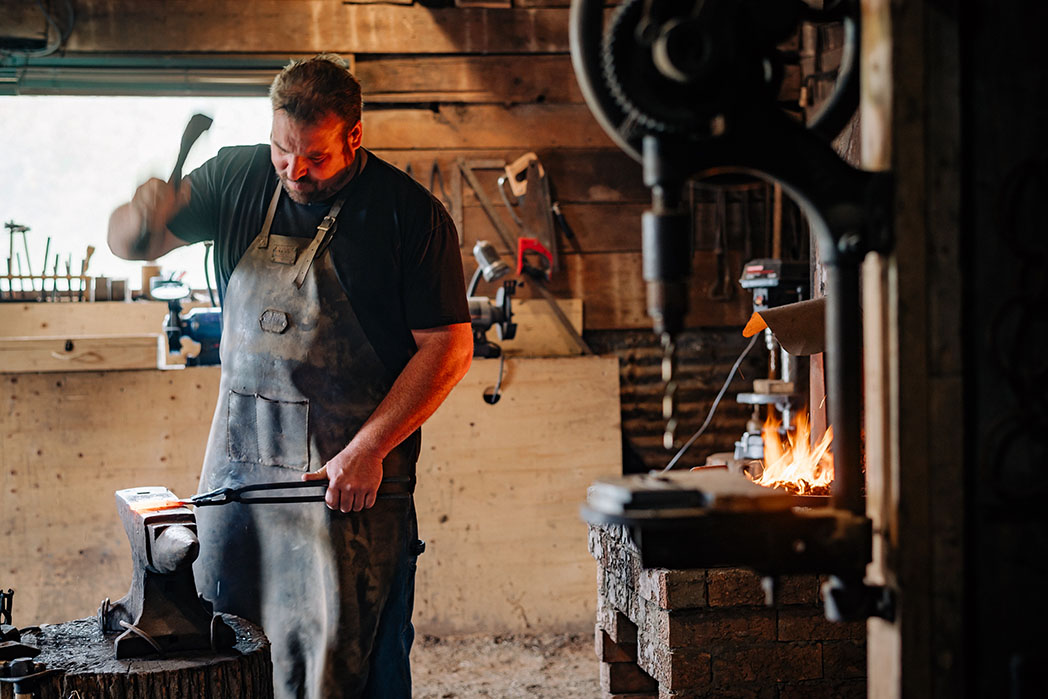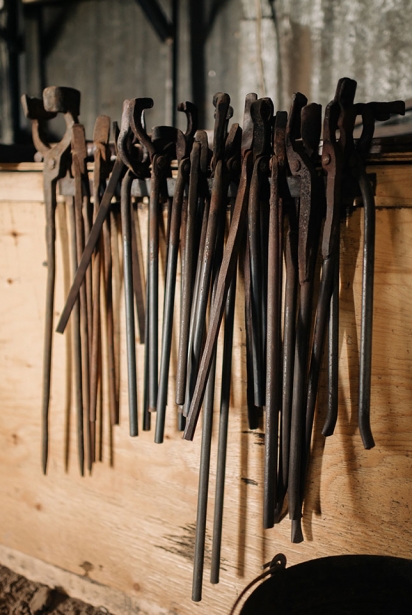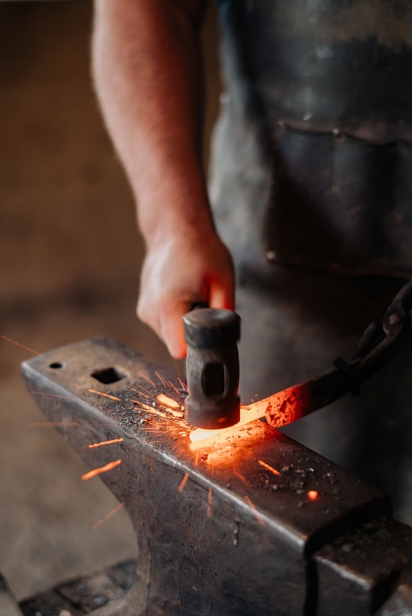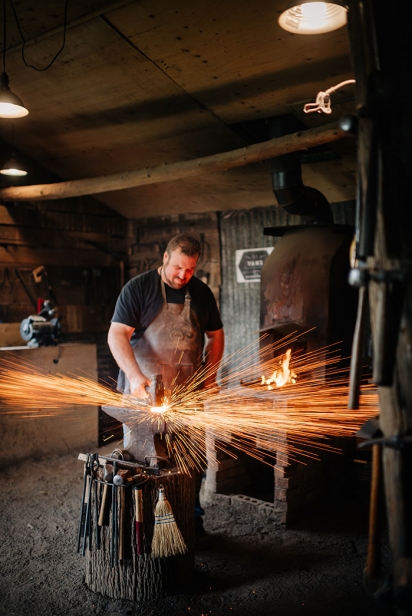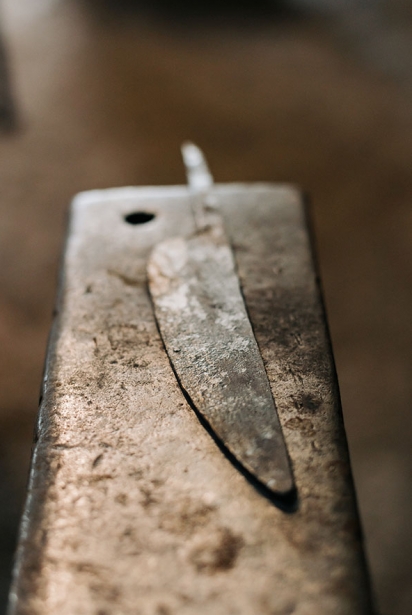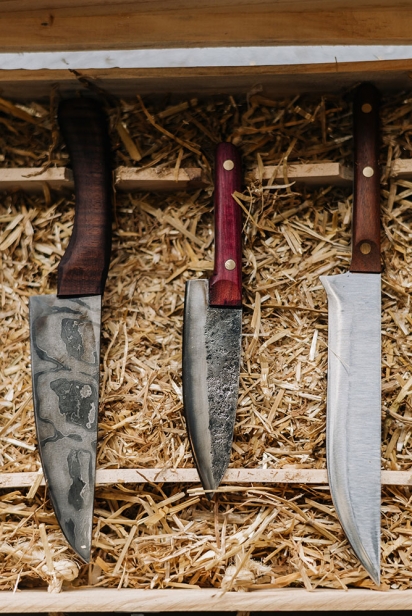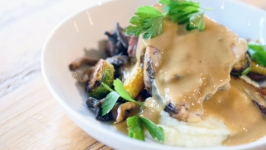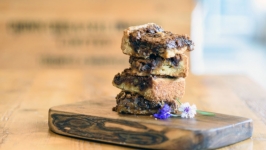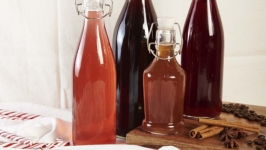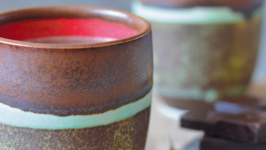Forging the Way
Drive 45 minutes east of Ottawa to the community of Hammond and you can take a trip back in time… to the Iron Age.
Though there’s nothing primitive about Josh Van Noy, he does ply a trade that dates back as far as 1500 BC when man first began making tools with iron. He’s a blacksmith who spends his days working and teaching the trade in a shop adjacent to the rural home he shares with his wife, Gabrielle, and their baby, Rosalie, born just eight days before edible Ottawa visited.
A burly man — an archetypal look for a blacksmith — he greets visitors outside the shop, wearing jeans and a T-shirt though it’s only 11 Celsius. Inside, it’s slightly warmer, thanks to the smoldering coals on his forge, though it still doesn’t feel like T-shirt weather. But the congenial man, who quickly dons a heavy leather apron imprinted with his company name — Vans School of Blacksmithing — will soon be working up a sweat.
Van Noy, who is 39 years old, joined the military right out of high school, moving to the regular force from the militia, but an injury soon forced him out. That’s when he decided to pursue a trade.
“The first trade I took was blacksmithing,” he says. “I wanted to take it as a precursor to machining. I figured if I wanted to be a machinist, I should start where all metal-working started. I ended up going on and doing machining and millwrighting together and did on-the-job training with a variety of different shops.”
He worked in machining until a downturn in the economy prompted Dart Aerospace in Hawkesbury to initiate layoffs. He was the low man on the totem pole so he lost his job. That’s when he decided to go back to school. He took a two-year diploma in business and education and briefly taught extreme sports and search-and-rescue in Nova Scotia.
“That’s where I cut my teeth in education, but throughout it all, I was still blacksmithing.”
This, in spite of pretty regular moves within Ontario and to the East Coast. But he was able to keep blacksmithing because he had a portable blacksmith’s shop — everything he needed fit on a trailer.
“Sometimes [my workshop] was no better than a tree covering my forge so I could get some shade,” he says with a laugh. Such is his passion.
After Nova Scotia, he went to work for Lee Valley Tools before taking a job with the City of Ottawa, setting course curriculums for the Cumberland Museum.
“I did that until we bought this place four years ago and I decided to transition to full-time blacksmithing and teaching the trade.” The plan, after Gabrielle finishes her maternity leave and returns to work, is to move the shop closer to the city and hire staff to help him expand the education part of the business.
These days, he teaches between three to five days a week — every Saturday, Sunday and Monday. Tuesdays are reserved for school visits and Tuesday evenings, he teaches an introductory program promoted Breakaway Experiences. Wednesdays he does teambuilding workshops for area workplaces. “We have one where everyone makes an axe and at the end of the day, we have a little healthy competition throwing the axes outside. That’s the fun part of blacksmithing.”
In six hours, he can teach a class how to make a kitchen knife and each participant will leave with the one they made. When he’s working on his own, it takes him about an hour to make a kitchen knife and he spends the rest of his days completing custom orders for everything from tools for other blacksmiths — his peers who, unlike him, don’t like making the tools of the trade — to swords and shields for historical re-enactments.
Knife-making 101
Asked to talk about the process of making a knife, Van Noy just goes ahead and makes one. He starts with a piece of “medium carbon steel” or “round steel.” It’s a solid rod, measuring nearly an inch in diameter and 4.5 inches in length. It weighs about 15 ounces.
He uses his tongs to hold the steel in his forge and about a minute later, he brings it back out. It’s bright orange and red hot, but not as hot as it will get.
Once he gets the steel up over 1500F, the material starts to oxidize and he starts to see delamination, the process through which metal fails and fractures into layers.
“That’s when you get a dull red colour. We’re going to push it up to almost 2100F where we’ll get a nice bright yellow.”
At the yellow point, he starts hammering. First, he flattens the rod. The noise of the hammer on the steel atop his anvil is deafening, but not literally so. He’s quick to point out that to cause hearing damage, you need 85 decibels of noise, sustained over a period of 20 minutes. He definitely gets past 85 decibels, but only for bursts of about 15 seconds each time.
“Everyone has different levels of sensitivity and I always encourage students to be safe, so we have ear protection and all that stuff,” he says — not that he himself wears any. After all, he learned from the “old-school boys” who worked unencumbered by such precautions.
He continues with the heating and hammering as the blade begins to take shape. When he hammers, he warns bystanders to stay well back as small pieces of steel — known as mill scale “or FE302 if you want to get technical” — fly off in the form of sparks.
“We try to keep the temperature under the threshold of melting, but you want the steel as plasticine as possible to make it do what you want it to,” he says. “As we hammer it out, we’re refining the steel and it’s giving us a better-quality material.”
Once he gets to this stage, he needs to decide what kind of knife to make.
“There are so many options,” he says. “The sky’s the limit.”
Today, he decides he’ll make a Japanese-style knife — the kind that have the artful markings across the blade.
After he’s happy with the shape of the blade, he creates an indent in one end. This is known as the knife’s tang, where the handle will go. After he’s done forging, he then grinds the blade, using the only power tools he has in the shop. Then it’s time to burn the tang into what will become the wooden handle.
After that, he “quenches” the blade, a process through which he heats up the knife to 1500F and then dips it in room-temperature oil to harden it. Following that, he heats the knife up very slowly and watches for what he calls the tempering colours. Once that’s done, it gets another quick grind to clean off any oil and then he uses epoxy to bind the blade and handle together. The last stage is to shape the handle, which he likes to do once it’s attached to the blade so he can be sure it’s well balanced. Then he sharpens the blade in preparation for the final and easiest step: testing the knife in the kitchen.
Every blacksmith has his or her own approach to production. If he doesn’t have a custom order or a pre-conceived idea, he just lets the metal flow.
“There’s a lot of room for interpretation,” he says. “You can be as artistic as you want. Blacksmithing has a little something for everybody.”
The beauty of the blacksmith’s trade
It’s not surprising Van Noy decides to make a Damascus knife for his demo. After all, he learned this style of knife-forging at the hands of Japanese master Masashi Yamamoto.
Yamamoto represents the 14th generation of knife forgers, officially known as bladesmiths, in his family. He works in the mountains of northern Japan and is known for wearing nursing scrubs while he forges — no protective gear of any kind. He’s also known for letting his face get close enough to the hot piece of steel to light his cigarettes off of it. Through Knifewear, the high-end knife shop in the Glebe, Yamamoto has travelled to Canada for demonstrations and that’s where Van Noy met him and studied under him. Van Noy provides the equipment for Knifewear’s demos.
“He leaves an impression,” Van Noy says of Yamamoto. “And he’s invited me to Japan. Once the baby is a little older, that’s a trip we’ll make for sure.”
Van Noy says the beauty of his trade is that blacksmiths are completely self-reliant. It’s actually called a “cornerstone trade” because traditionally, every other trade needed the help of a blacksmith.
“Every developing civilization all over the world had some kind of ’smith,” the history buff says. “There’s no real exception to that.”
For food lovers, the beauty of having knives custom-forged is the variety you can request, right down to how heavy or light the blade is and how the blade balances with the handle. His kitchen knives start at about $200 while the Japanese-style versions with patterned steel cost closer to the $400.
“It’s about what the customer likes and wants,” he says.
Van Noy says he gets about a dozen orders for kitchen knives a year.
You, too, can make a knife
He works on custom orders two days a week, but teaching is what takes up most of his time. He can take up to eight students at once and he’s never had a student leave without producing something, from raw form to finished product.
Most of his students are male, but he estimates about 20 per cent are female.
“We get a higher number of male participants — it’s probably due to the stereotype of some big burly guy wailing on steel,” he says, looking every bit the stereotype himself. “The truth is that the heavy, heavy work we associate with blacksmithing is only in the very beginning. Soon, you’re trading that power for control and accuracy. And we are getting more interest from women. They’re doing the knife and axe classes.”
Meanwhile, in the trade itself, he thinks the number of females is climbing. Anecdotally, from what he sees in his professional circles, he estimates the split is about 60 per cent men and 40 per cent women.
“This trade was dying off by the First World War when women were entering the workforce, so it wasn’t something women transitioned into,” he says. “But that may be changing.”
Van Noy is passionate about sharing his craft; he is one of a handful of certified blacksmiths and, as an instructor, he likes to let people know they can still attain this certification in Ontario.
“That’s why I started a school — to give people an opportunity to try it. If you like it and want to do it as a hobby, we can help you do that. But there are even career opportunities.”
For now, though, he’s returning to the house to spend some time with his infant.
“It’s only been eight days and I can’t imagine my life without her,” the beaming father says.
Vans Blacksmithing
649 Saint Félix Rd, Hammond, Ont.
vansblacksmithing.ca | 613.859.6658
Blacksmithing bachelorette?
Don MacKay, of Forged in Canada, does classes for between one and 12 people. MacKay has hosted everything from bachelorette parties and family events to corporate team-building events. Over the years, his students have ranged in age from eight to 80. In a one-day course, you could come away with a cup rack, a wall-mounted pot rack and some hooks and in a two-day course, you learn the basic forging techniques and you’ll leave with several additional items, such as a loon-head fire poker, fire fork, beer opener, toilet-paper holder. Group events are a bargain, with prices of $30 a person for a half-day to $50 for a full day. They can take place in the daytime or in the evening and there’s no experience necessary. He estimates he's taught 300 people in the past year.
Forged in Canada
18124 Highway 7, Perth, Ont.
forgedincanada.com | 613.267.9979
@forged_in_canada
The knife nerd
Japanese knife-making is a 1200-year-old tradition, with craftsmanship and expertise built over a lifetime. In his book, The Knifenerd Guide to Japanese Knives, Kevin Kent, author and owner of Knifewear, relays his extensive knowledge and passion on the subject of Japanese knives. It takes you behind the scenes with a personal look into the lives, skills and ancient artistry of Japanese blacksmiths. The book was recently shortlisted for the Taste Canada Award, the only awards program that recognizes and honours cookbooks by Canadian authors.
Knifewear is always offering new classes, knifesharpening and forging demonstrations, often by blacksmiths visiting from Japan. Sign up for their newsletter to be the first to hear about upcoming sessions.
Knifewear
800 Bank St., Ottawa, Ont.
knifewear.com | 613.695.4200 | @knifewear


